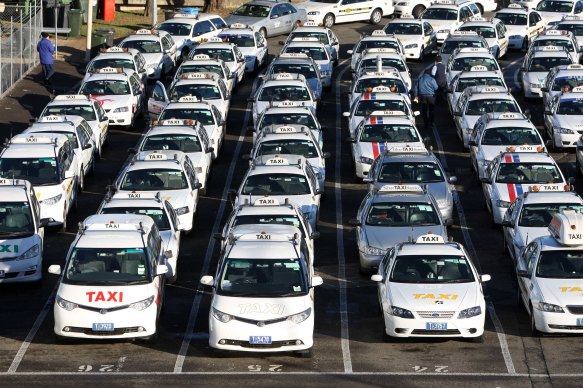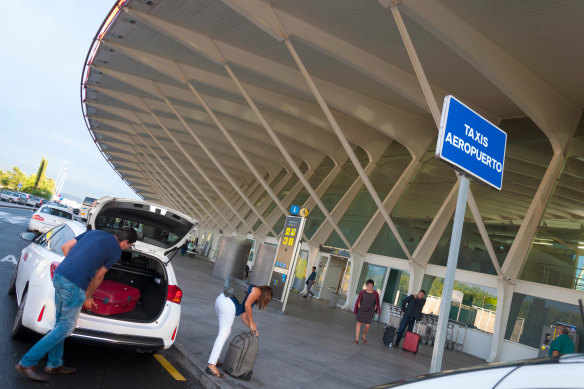Opinion
Taxi drivers upset with Ubers at the airport? Cry me a river
Ben Groundwater
Travel writerImagine if real estate agents went on strike. Imagine if, this weekend, there was no one in a tight suit and pointy leather shoes to show you around that rental apartment; if you had to just go in and have a look yourself.
Imagine buying a house: there would be no one to tell you why this rundown property across the road from the train tracks is worth $3 million. No one could tell you that another hellhole has a price guide that’s clearly about half a million dollars less than it will end up going for.

Taxi drivers recently refused to pick up passengers at Sydney Airport in protest over a new Uber pick-up zone.Credit: Lee Besford
You would have to just look around at these properties yourself and negotiate a deal directly with the owners.
No real estate agents for a whole weekend. It sounds … I mean, yeah, it sounds great. It sounds like whatever reason the agents had for striking, it would backfire because no one would miss them. If anything, we would celebrate.
I say this because Sydney taxi drivers went on strike last week, refusing to pick up any passengers from the International terminal at the airport. They were protesting the NSW government’s plan to trial a new Uber pick-up zone next to the taxi rank at the airport, where Ubers would queue for passengers in the same way cabs do (rather than picking up from a car park an extra five-minute walk away, after waiting in an off-site rank).
Melbourne Airport has had this system for years now, so it’s not exactly revolutionary. And if you’re struggling to muster sympathy for the striking taxi drivers, you’re not alone. Despite the decimation of their industry since Uber was launched in Australia in 2012, taxi drivers are up there with real estate agents (and, yes, journalists) when it comes to love from the public.
That’s probably because the service they offer is notably and consciously worse than that of their ride-share competitors.
Even before Uber was launched, people were sick of being taken on the scenic route by taxi drivers, having to pay far more than they should (a colleague was recently charged $90 for the journey from Sydney Airport to Woolloomooloo, which is outrageous), having no control over who would be driving them, and having little recourse to complain if the service wasn’t up to scratch.
Uber was a massive disrupter, far cheaper and a better product than taxis. Despite the company’s inevitable “enshittification” – that is, the decline in quality and rise in price – it is still better than its competition.
I don’t know how anyone could argue this, or be surprised by it. I take taxis every now and then just to see if I’m missing out, and they’re still terrible. Too expensive, unreliable, and not very clean or comfortable. Too easy to get ripped off.
There’s another reason I struggle to sympathise with the striking cab drivers: I’ve seen what the world looks like without ride-sharing apps, and it isn’t good.

Rideshare services are banned in Spain’s Basque Country.Credit: Alamy
Uber and its ride-share competitors are banned in one of my favourite destinations in the world, the Basque Country of Spain, no doubt as a protectionist policy for its established taxi driver network. But if you then expect that that network will provide an excellent service, you will be very much disappointed.
With no competition, taxis in the likes of San Sebastian just do whatever they want.
They don’t allow passengers to hail them from the street – you have to go to a designated taxi rank (of which there aren’t many), or call to make a booking. They’re expensive, far more so than you would expect with a ride-sharing app. And the service from drivers can sometimes be friendly, sometimes surly, sometimes incredibly rude.
A friend tried to catch a taxi in San Sebastian recently for a very short journey, as she wasn’t able to walk, and was screamed at by the driver and ended up leaving the car in tears.
Uber isn’t a perfect company. Far from it. The company ignores local regulations, plus has been involved in a whole swag of controversies and misdemeanours.
Its inadequacies are shown up in countries that offer a better alternative.
Try Singapore, where Uber doesn’t exist, but there is Grab, a service that works in much the same way, just as efficient, and slightly cheaper. Or countries such as Georgia, where people use the Estonian company Bolt, which was also very good.
And then there’s Japan, which does have Uber, though its regular taxi system is so well run, so reliable, and so similar in price to Uber – not to mention providing a cultural experience of its own for passengers – that visitors rarely bother with a ride-sharing app.
All of which brings us back to the taxi drivers of Sydney, who are upset that Uber is going to have a waiting area at the airport much the same as their own, close to the terminal, convenient, and, you would presume, poised to take even more business away.
Most passengers won’t be too sympathetic. You can bet your house on it.
Sign up for the Traveller newsletter
The latest travel news, tips and inspiration delivered to your inbox. Sign up now.